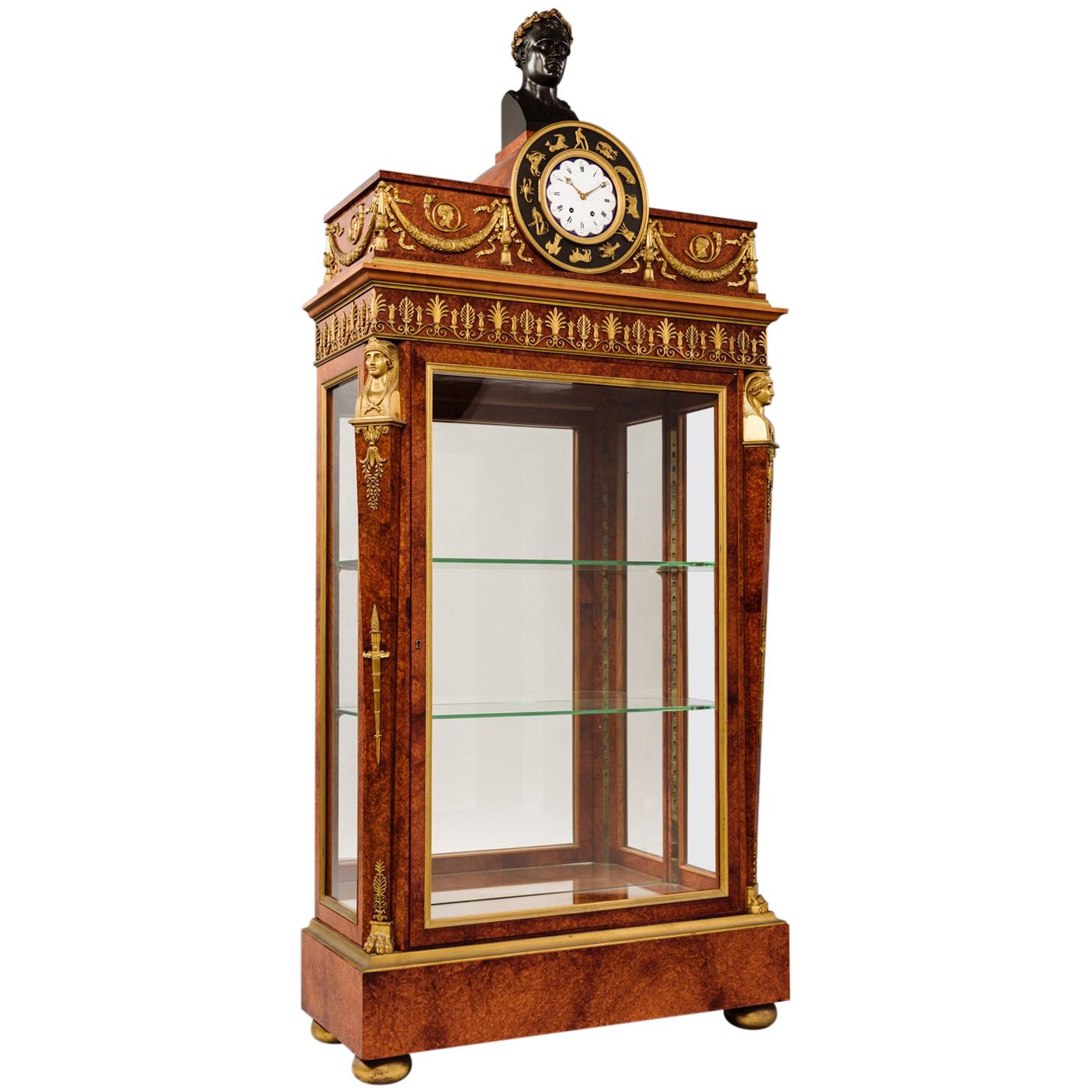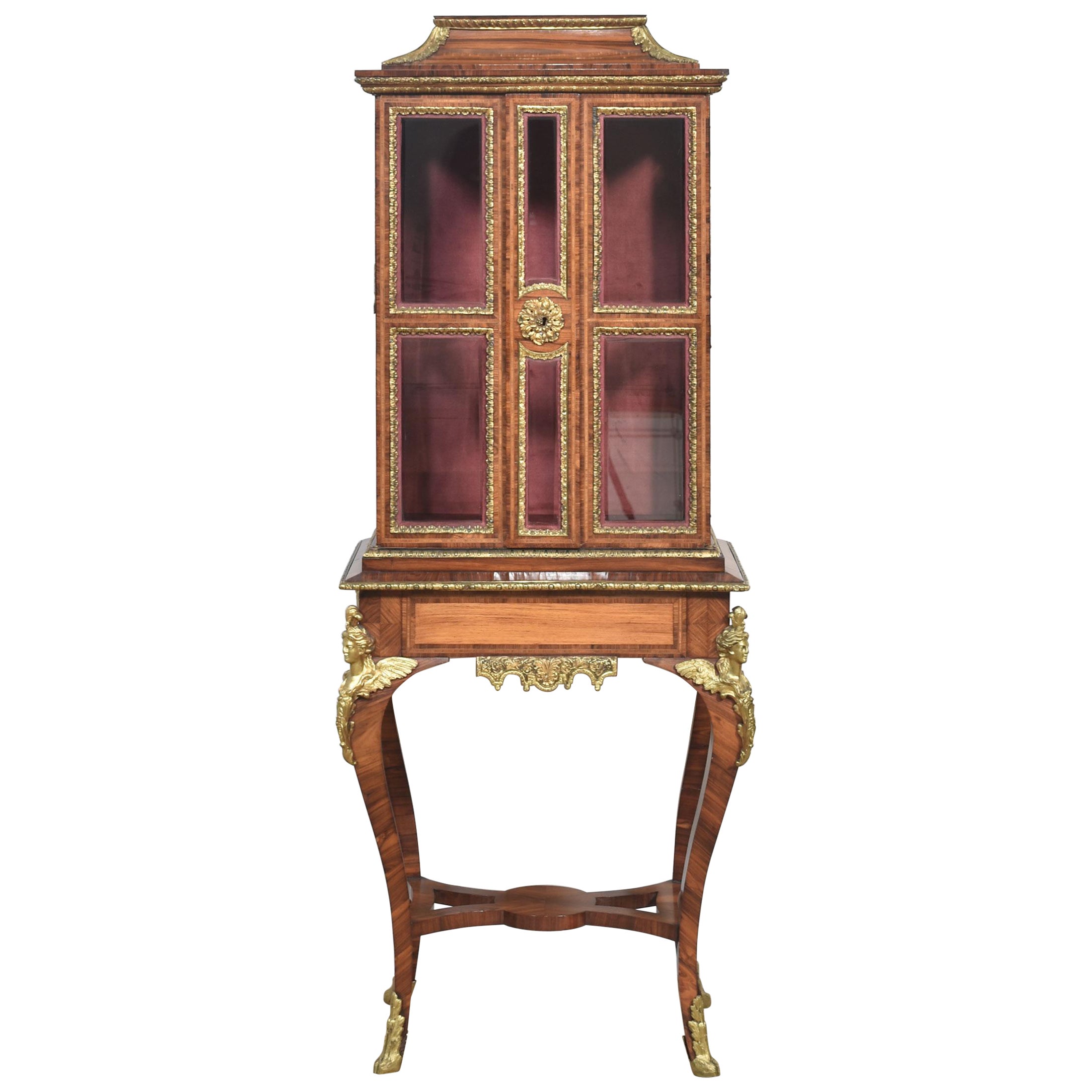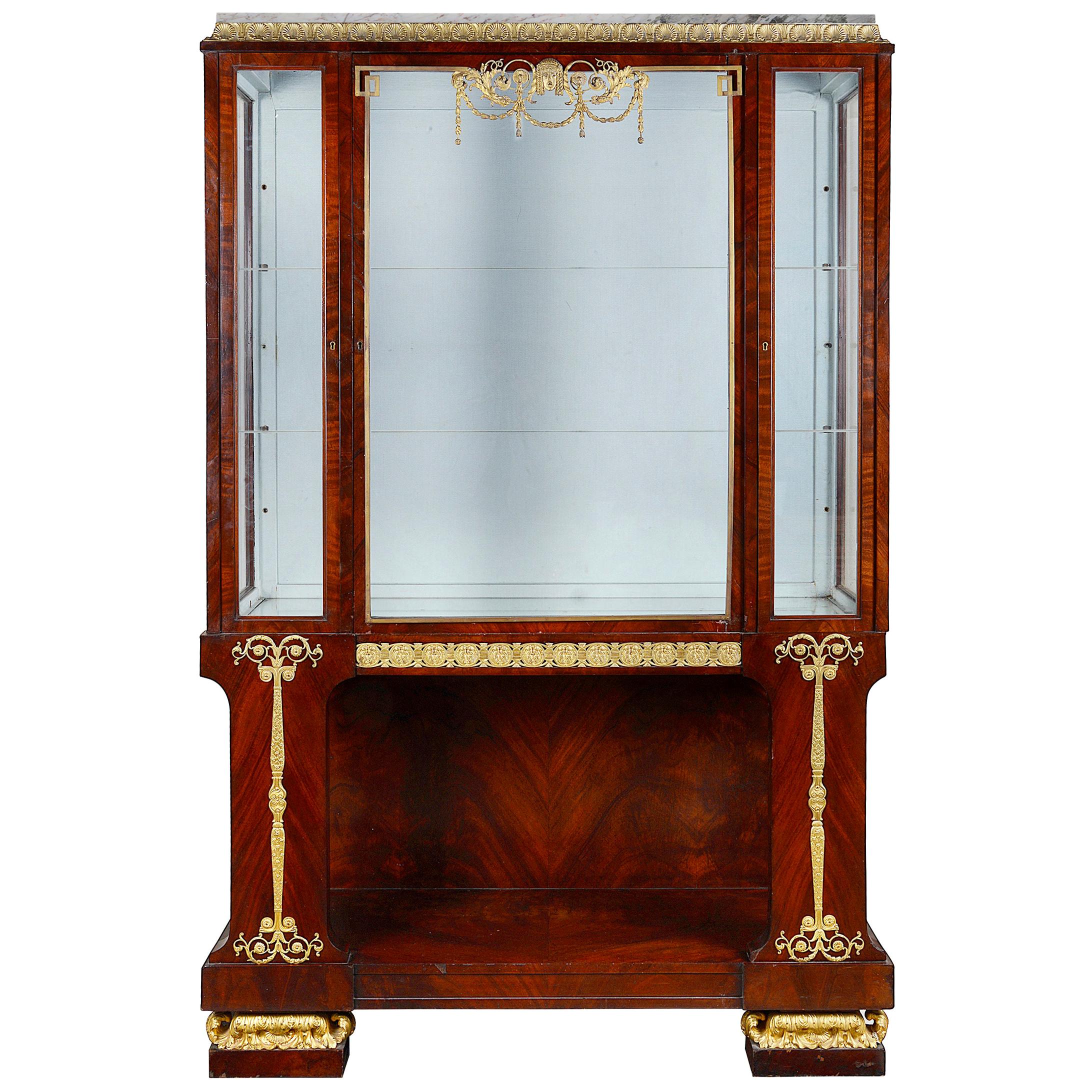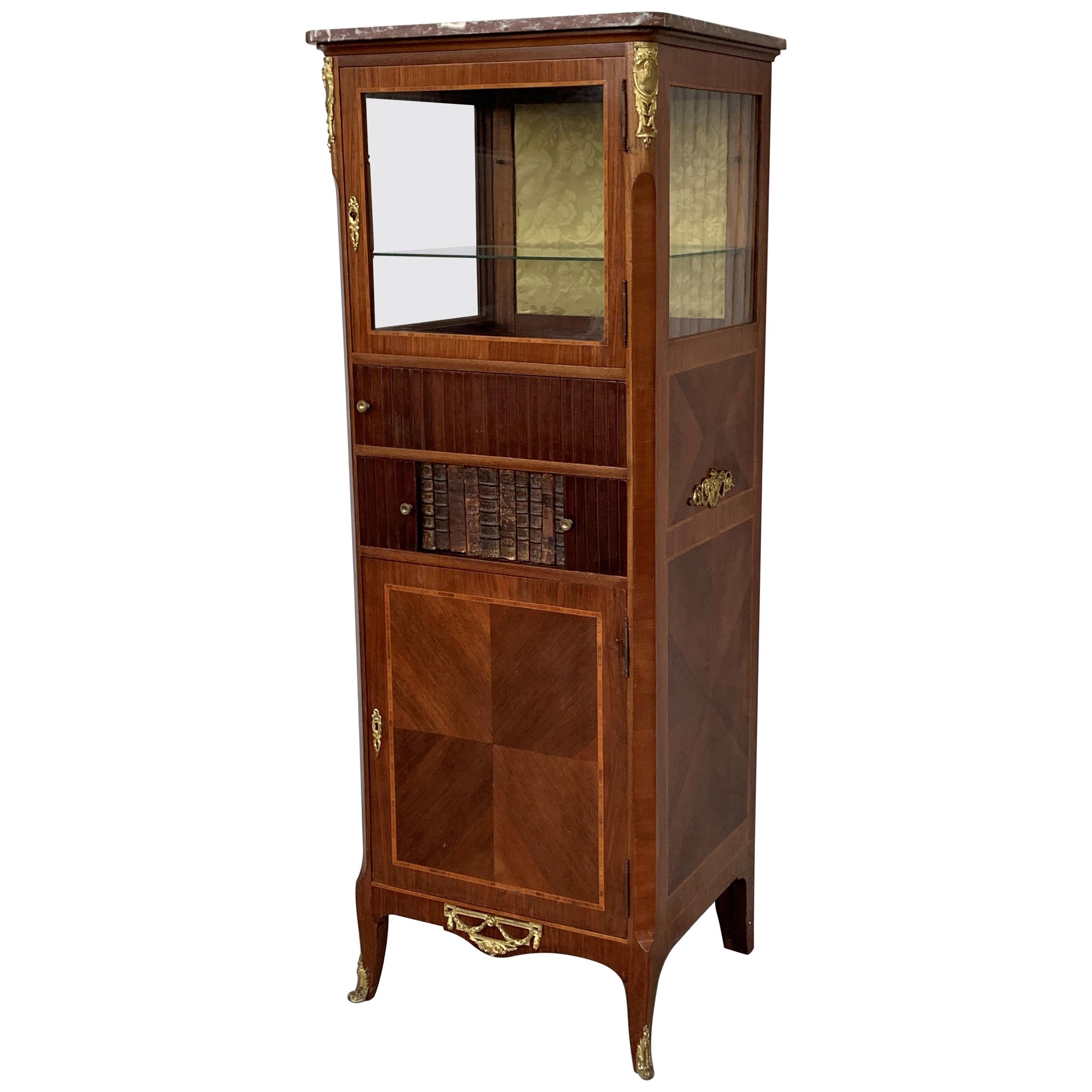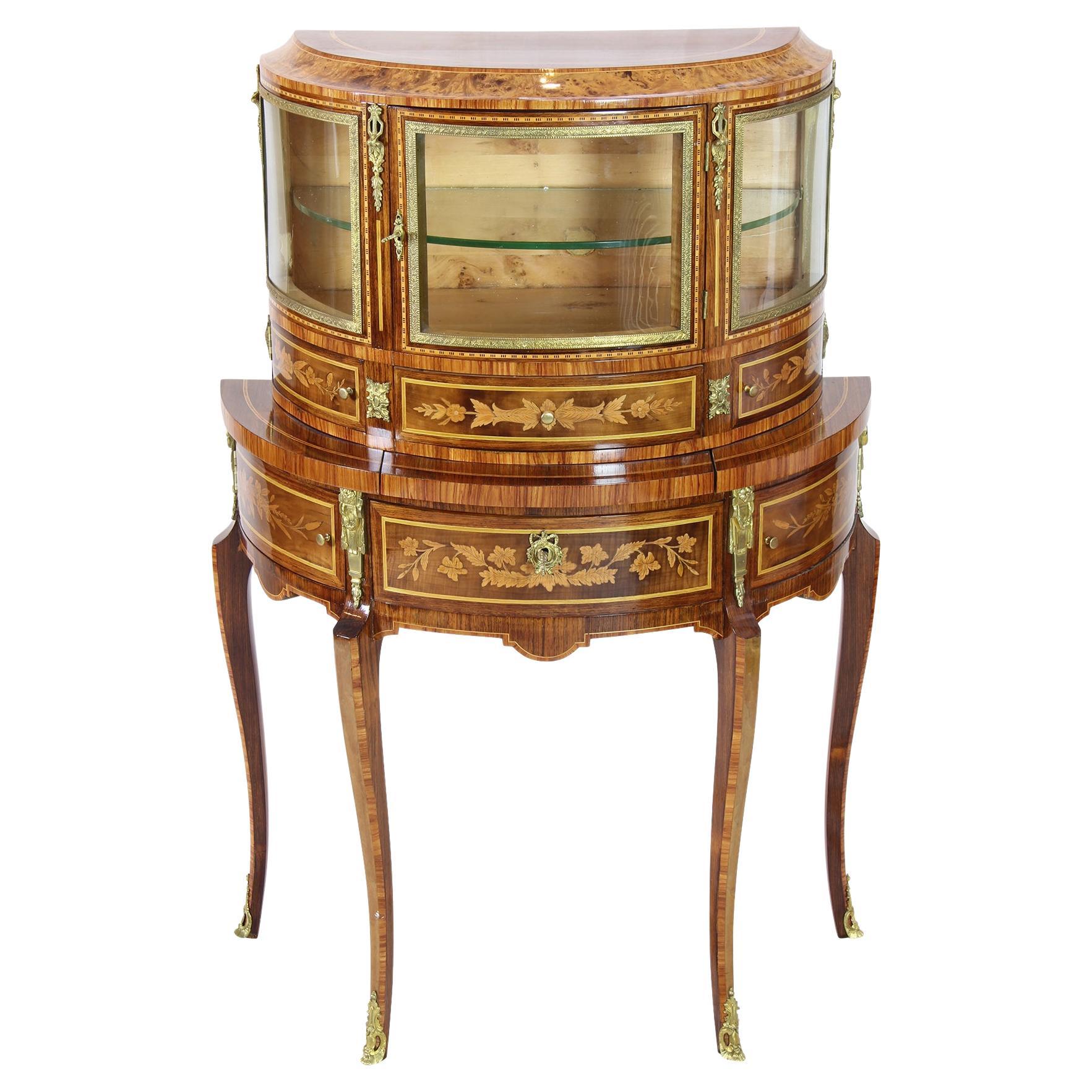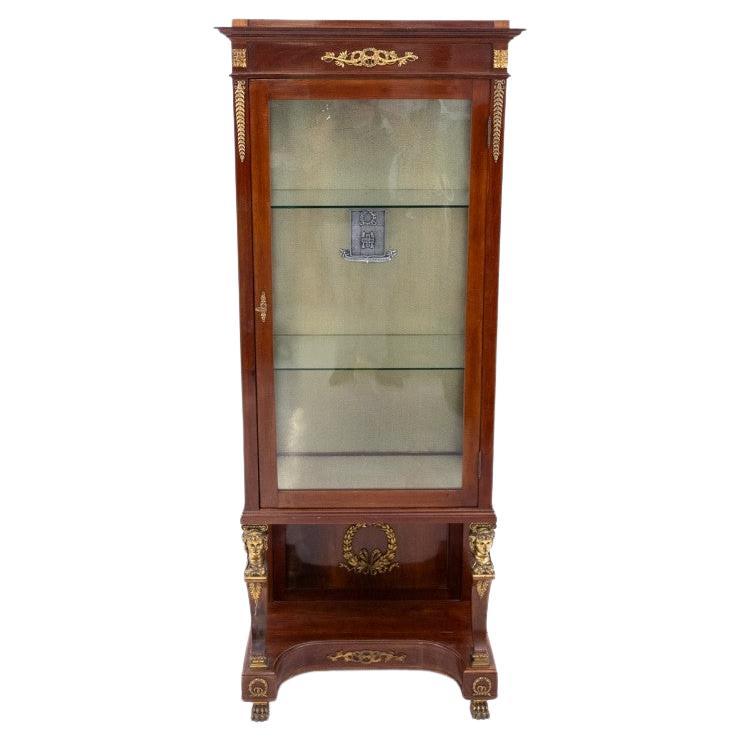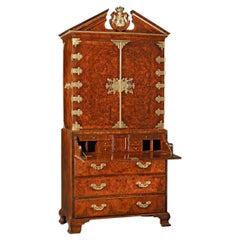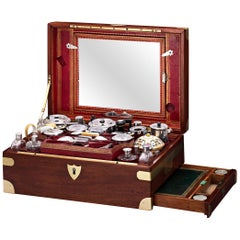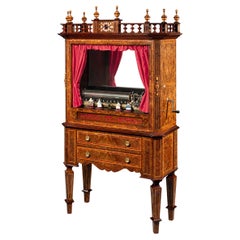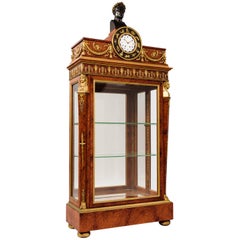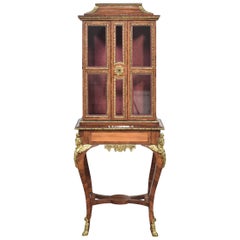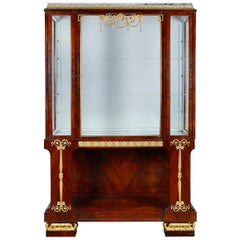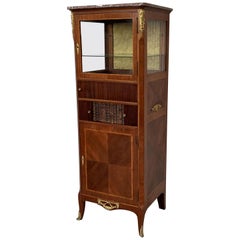Items Similar to 19th Century Watch Winding Display Cabinet
Want more images or videos?
Request additional images or videos from the seller
1 of 5
19th Century Watch Winding Display Cabinet
$42,500
£32,457.49
€37,178.30
CA$60,628.83
A$66,080.01
CHF 34,411.49
MX$797,304.08
NOK 432,566.28
SEK 406,079.13
DKK 277,674.74
About the Item
This incredible, one-of-a-kind watch display cabinet brings together the beauty of an antique with the functionality of modern technology. Crafted of mahogany, this 19th century jewelry display cabinet has been ingeniously retrofitted with an electrified watch winding system. Located in its top three drawers, it is capable of winding up to 14 automatic movement watches at one time. With the flip of a switch, the watch holders seamlessly swing back and forth, triggering the automatic winding mechanism in each watch.
When not being used, one's favourite timepieces can be displayed beneath the glass-covered surface. Lined with black velvet, it makes for an elegant presentation befitting one's best horological treasures. The lower cabinets offer even more storage space in this Empire-style cabinet, making it as functional as it is elegant. A marriage of 19th century craftsmanship and present-day innovation, it is an extraordinary find.
Measures: 42 1/2" high x 49 9/16" wide x 28 1/4" deep.
- Dimensions:Height: 42.5 in (107.95 cm)Width: 49.57 in (125.91 cm)Depth: 28.25 in (71.76 cm)
- Style:Empire (In the Style Of)
- Materials and Techniques:
- Place of Origin:
- Period:
- Date of Manufacture:19th Century
- Condition:
- Seller Location:New Orleans, LA
- Reference Number:Seller: 30-18011stDibs: LU89118096043
About the Seller
5.0
Recognized Seller
These prestigious sellers are industry leaders and represent the highest echelon for item quality and design.
Established in 1912
1stDibs seller since 2010
113 sales on 1stDibs
Typical response time: 9 hours
- ShippingRetrieving quote...Shipping from: New Orleans, LA
- Return Policy
Authenticity Guarantee
In the unlikely event there’s an issue with an item’s authenticity, contact us within 1 year for a full refund. DetailsMoney-Back Guarantee
If your item is not as described, is damaged in transit, or does not arrive, contact us within 7 days for a full refund. Details24-Hour Cancellation
You have a 24-hour grace period in which to reconsider your purchase, with no questions asked.Vetted Professional Sellers
Our world-class sellers must adhere to strict standards for service and quality, maintaining the integrity of our listings.Price-Match Guarantee
If you find that a seller listed the same item for a lower price elsewhere, we’ll match it.Trusted Global Delivery
Our best-in-class carrier network provides specialized shipping options worldwide, including custom delivery.More From This Seller
View All19th Century French Vitrine by Francois Linke
By François Linke
Located in New Orleans, LA
This rare and stunning vitrine was crafted by the illustrious French ébéniste François Linke. A master of the Louis XVI style, Linke was renowned for his highly original designs that...
Category
Antique 19th Century French Rococo Vitrines
Materials
Bronze
King George I Ambassadorial Secrétaire-Cabinet
Located in New Orleans, LA
This highly important secrétaire-cabinet was crafted for and specially ordered by King George I for the British Ambassador to Russia. From its craftsmanship and materials to its exceptional artistry, it is a work of royal and historic significance that exudes power in each and every detail. The broken pediment at its apex features the simplified royal coat of arms bearing the king’s crown, while the interior is adorned by portraits of the British Royal Family. Placed within the ambassador’s St. Petersburg home, this entirely unique piece of furniture would have been a potent reminder of England's grandeur and political importance.
Relations between England and Russia during this period were at an all-time high. Peter the Great had traveled to England in 1698 as part of his widely known “Grand Embassy” tour, wherein he attempted to gain foreign support against the Ottoman Empire. He spent a period of nearly four months there, meeting with King William III and his court on numerous occasions. Noted academic Arthur MacGregor wrote concerning the impact of the trip, “For two decades following Peter's visit, British influence in Russia reached a peak. It manifested itself in social custom, in craft practice and in ships and naval organization... it reached a significant sector of the population before relations cooled once again and the two nations pulled back from this era of unprecedented cordiality.”
First and foremost, however, it is a reminder of British might and influence. By the reign of King George I, England had come into its own as a world power. Unique in its design, this cabinet is a reflection of the country’s might. It is crafted from the highest-quality solid walnut and burr walnut adorned by gilded lock plates and engraved hinges. The presence of ormolu at its apex and lining the doors was a rarity for this period, and its addition makes manifest the importance of the design.
The outer doors open to reveal multiple interiors, including fifteen separate drawers around a central cupboard; the cupboard doors each bear mezzotint portraits of George I and his father, Ernest Augustus, Elector of Hanover. An etching after the portrait of George I dating to circa 1716 is in London’s Royal Academy. A second, inner pair of doors are adorned by mezzotints of the Prince and Princess of Wales (later Queen Caroline and George II), which are both after portraits by Sir Godfrey Kneller dated 1716 in the Royal Collection. A final portrait is revealed on the very interior of the cabinet, where a mezzotint of Frederick, Anne, Amelia and Caroline, children of the Prince of Wales, resides. An etching (circa 1715-1720) after this portrait can be found in the National Portrait Gallery (London).
Apart from its abundance of royal portraiture, the cabinet features stunning painted decoration, including floral designs as well as clouds, birds and trees in a bucolic motif reminiscent of Eden. Its lower portion is a study in both form and function, featuring a fitted secrétaire-drawer above three additional drawers for storage. The cabinet appears in The Shorter Dictionary of English Furniture by R. Edwards from 1964, a text that is regarded as the bible of British furniture design. Edwards describes it as a “writing cabinet...given by George I to the British Ambassador at the Russian court.”
The cabinet was likely made for the 18th-century German diplomat and writer Friedrich Christian Weber, who represented English interests at the Russian court from 1714 until 1719. Although Weber’s tenure as ambassador was relatively short, while in St. Petersburg, he authored his account entitled Das veraenderte Russland (The Present State of Russia), which was published in three volumes in 1721, 1739 and 1740. It may, however, also have been made for George Douglas, 2nd Earl of Dumbarton, who served as ambassador alongside Weber in 1716. Diplomatic relations ceased between the two countries in 1721.
In 1928, the cabinet appeared for sale at the International Exhibition of Antiques & Works of Art in Olympia. It had previously been in the collection of the Woltner family of Bordeaux, the celebrated vintners who owned the estate Château Laville Haut-Brion and produced wine of the same name. According to the family, Monsieur Woltner was given the cabinet as a gift from an aunt who lived in Russia for many years. After leaving the Woltner collection, the cabinet was acquired by William Berry...
Category
Antique 18th Century English Georgian Secretaires
Materials
Brass
French Nécessaire de Voyage
Located in New Orleans, LA
This exceptional and rare French nécessaire de voyage is almost certainly the work of the highly respected Parisian manufacturer Pierre-Dominique ...
Category
Antique Early 19th Century French Empire Historical Memorabilia
Materials
Crystal, Silver
$78,500
Mermod Fréres Station Cylinder Music Box
By Mermod Frères 1
Located in New Orleans, LA
This exceptionally wonderful and rare automaton cylinder musical box by the Mermod Fréres firm of Sainte-Croix, Switzerland is a marvel of musical crafts...
Category
Antique 19th Century Swiss Other Musical Instruments
Materials
Walnut
19th Century Coromandel Inlaid Vitrine
Located in New Orleans, LA
Highly-prized coromandel, or East Indian ebony, was used to create this beautiful Victorian vitrine. Featuring delicate inlay in the Victorian/Edwardian style and glass panels framed in the equally luxurious satinwood, this cabinet is constructed to fit flush against a wall with baseboards. Elegant cabinets such as this are perfect for displaying one's treasures, but with original locks, keys, mirrors and fleur-de-lis fabric, this case is a prized possession unto itself,
circa 1890.
Measures: 30" wide x 14 ½" deep x 41 ½" high.
Coromandel ebony is variegated brown and black, often called "streaky," wood. It is considered a highly valuable wood for turnery, fine cabinet...
Category
Antique 19th Century English Victorian Vitrines
Materials
Glass, Mirror, Ebony, Satinwood
18th Century English Secretary
Located in New Orleans, LA
Queen Anne period furnishings such as this walnut secretary are incredibly rare and important examples of English cabinetmaking. This secretary is of the most outstanding caliber, boasting desirable double bonnet, mirrored cabinet doors...
Category
Antique 18th Century English Queen Anne Secretaires
Materials
Walnut
You May Also Like
Empire Style Vitrine Cabinet with Integral Clock by Eugene Brunet
Located in Brighton, West Sussex
A very fine Amboyna wood and gilt-bronze empire style vitrine cabinet with a glazed front and sides. The cabinet is mounted all over with superb quality well chiselled gilt-bronze mounts and surmounted by a clock with an enamel dial face surrounded by Zodiac motifs. The cabinet is crowned with a bronze bust of Napoleon.
Signed E. Brunet.
French, circa 1880.
Eugene Brunet was one of the most successful ébénistes of high-quality Parisian furniture during the late 19th and early 20th centuries. He produced items for wealthy patrons and exhibited at many of the international exhibitions of the period. In 1889, he joined brothers Frederic and Alexandre Roux, establishing themselves at 20 rue de la Perle under the name of Roux Et Brunet...
Category
Antique Late 19th Century French Empire Vitrines
Materials
Ormolu
19th century display cabinet on stand
Located in Cheshire, GB
Display cabinet on stands the moulded pagoda-style top above bevelled glazed doors opening to reveal a velvet-lined interior and single glass shelf. The base section fitted with free...
Category
Antique 19th Century British Cabinets
Materials
Wood
Empire Influenced Display Cabinet, circa 1920
Located in Brighton, Sussex
A stunning French mahogany Empire style vitrine with classical gilded ormolu scrolling mounts, glass shelves, a flamed mahogany panel beneath with a shelf and raised on classical car...
Category
Early 20th Century French Empire Revival Vitrines
Materials
Ormolu
French Late 20th Century Louis XVI Period Mounted Cabinet Vitrine
Located in Miami, FL
An extremely high quality and elegant French late 19th century Louis XVI period mahogany and ormolu-mounted cabinet vitrine which is finished on all sides. The cabinet is raised by t...
Category
Early 20th Century French Empire Vitrines
Materials
Cherry
$4,780 Sale Price
20% Off
Louis XVI-Style Demilune Display Vitrine with Marquetry and Brass, circa 1890
Located in Darmstadt, DE
This exceptional Louis XVI-style demilune display vitrine was crafted around 1890 with remarkable refinement and attention to proportion. The elegant half-moon form rests on slender,...
Category
Antique 19th Century French Louis XVI Vitrines
Materials
Bronze
Empire style display case, late 19th century, Southern Europe.
Located in Chorzów, PL
Empire style display cabinet from the late-19th century, from Southern Europe. Richly decorated with decorative elements made of brass, equipped with two practical glass shelves.
Wo...
Category
Antique Late 19th Century French Empire Vitrines
Materials
Glass, Walnut
More Ways To Browse
Watch Holder
Antique Jewelry Cabinet
Antique Watch Holder
Watch Cabinet
Empire Display Case
Jewellery Display Cabinet
Jewelry Display Cabinets
Used Jewellery Display Cabinets
Watch Display Case
Antique Cherub Cabinet
Arched Display Cabinet
Art Populaire Cabinet
Bow Front Glass
Brass And Glass Curio
Cabinets With Mirrors 1920
China Cabinet Glass Doors
Cuban Mahogany Cabinet
Danish Hardware
